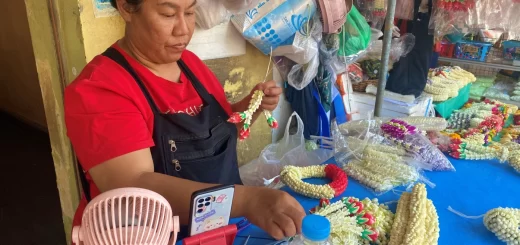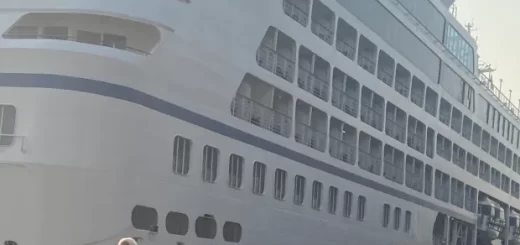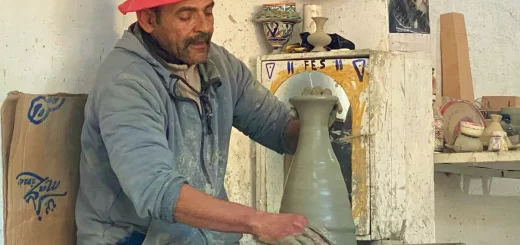Encountering animals not seen in these parts one of the joys of grand voyage
A pair of 5-ton elephants blocking our passage through Hluhluwe-Imfolozi Wilderness Park proved a great bonding experience among passengers going ashore in Richards Bay, South Africa. We were in the world’s oldest game reserve –founded in 1895. The 237,000 acre expanse, 170 miles north of Durban, had been established when it was realized that the elephants, giraffes, water buffalo, leopards and lions now known as the Big Five would go extinct unless something was done to save them.
Now this shore excursion from Oceania Cruise Line‘s 630-passenger Nautica was so popular that we’d been waitlisted months before our Jan. 18 departure. We lucked out, but now were blocked by elephants.
The huge animals in our path, wet from wallowing in a muddy creek, were among a herd of 32 we’d encountered just minutes into our 2-1/2 hour game drive an hour’s drive from the ship. “The mud helps rid them of a parasite that crawls on their skin,” said Tommy, our driver-guide, is his clipped South African accent. He wore a headset to stay in touch with drivers other vehicles taking visitors along the many trails criss-crossing the reserve. Among the elephants were a female with two younger animals — one born a few months prior and its adolescent sibling, according to Tommy. After blocking us for about 20 minutes, the animals lumbered off and we were back on our way.

Water Buffalo wallow in the mud to keep parasites off their skins. They are the most dangerous animals on a game drive. (Janet Podolak)
“These buffalo are the most dangerous in the reserve,” Tommy told as we approached a group also wallowing in the mud. “That’s because they give no warning when they’re about to attack.”
Nearby was a tree with what seemed like hanging fruit and pretty yellow birds flapping around. They’re weaver birds, we were told, named for the nests they weave.
Back at the ship that night we asked to be seated with other passengers so we could hear their stories of excursions taken that day. That’s where we met Mike and Debbie Krawczyk from Virginia and had the first of what would become several small world encounters. She, it turned out, has a brother in Mentor, my hometown.
A ship this size lets its passengers easily get to know one another. They become familiar as neighbors when sharing excursions ashore and back on the ship over shuffleboard, playing trivia and learning needlepoint.
Days spent at sea between ports have been especially conducive to long conversations, joining others for games, assembling puzzles and two-for-one Happy Hour afternoons. Extended mother-daughter time was another joyful, if unintended, perk.
I had intended to go alone on this voyage but two weeks before departure an old knee injury resurfaced and I was joined by my daughter. I’d financed the voyage with money saved to replace my aging Toyota and although I’d purchased insurance the injury had threatened to radically change my trip. I insisted I would go even if it meant canceling some plans ashore. My daughter, however, was furious with me. So I spoke to my travel agent about canceling the pricey single supplement I was paying and asked my girl to join me instead.
I’d most looked forward to a visit to Madagascar to see lemurs in the wild. But a cyclone to the south of our route had dumped lots of rain on the world’s fourth largest island and the trail climbing up into the jungle to see the creatures was even more hazardous than usual. So my daughter took that shore excursion instead, promising me photos and a full description.
“They don’t like their tails touched,” she told me, showing me photos of the winsome primates that predate monkeys and apes by millenniums. Lemurs perched on her shoulders and examined her hat inspiring giggles with their antics.
Despite my disappointment, passing on the excursion was the right choice for me, I learned. The jungle heat was oppressive and the mile-long, uphill trail was populated by roots and rocks as well as being muddy.. At least one fellow passenger was injured in a fall and others were unable to make the climb from the beach to the jungle.
Creatures that were a departure from the everyday squirrels, rabbits and robins we see at home was a voyage goal for us as well as our fellow passengers. We met large. hundred year old land tortoises on one island of the Seychelles, where they not only live in the wild but are kept and fed as pets. Our driver, Alan, who took us around part of Mahe Island by taxi, drove us into an area near his home where a dozen tortoises lived and were fed by residents.
Now we are spending three days in the Indian Ocean, en route to to Maldive. These sea days mark our 14th day on this cruise and we are just halfway through it.





Recent Comments